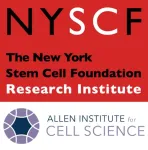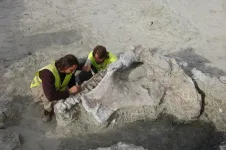(Press-News.org) ROCKVILLE, MD (September 4, 2024) The AIM-HI Accelerator Fund is pleased to announce that the 2024 Women’s Venture Competition’s first prize winner with distinction goes to HDAX Therapeutics led by its CEO and Co-Founder, Nabanita Nawar, Ph.D, and the Second Prize Winner goes to ARMA BIO, led by Co-Founder & CSO, Paraskevi Giannakakou, Ph.D.
The 2024 AIM-HI Women’s Venture Competition Committee reviewed more than 50 applications from 10 countries, including Canada, Ghana, India, Israel, Norway, Romania, Singapore, Spain, Thailand, and the United States. The Women’s Venture Competition winner must pass a rigorous evaluation by three of the competition’s blue-ribbon Committees: Selection, Judging, and Investment Due Diligence, whose members are world-class key opinion leaders, life sciences industry experts, investors, and entrepreneurs.
The Women’s Venture Competition is a first-of-its-kind program that provides funding, coaching, and networking opportunities to women-led oncology startups. The competition’s review committees provided assessments and recommendations for recognizing the Women’s Venture Competition winners based on scientific and clinical merits and business impact for cancer patients.
The Winners will be recognized at a Luncheon Award Ceremony with certificates and honorariums during the 2024 Global Summit and Award Ceremonies for Cancer Research & Entrepreneurship, co-hosted by AIM-HI and the National Foundation for Cancer Research on October 18, 2024, at the National Press Club in Washington, DC.
Driven by over 7 years of research, HDAX has developed a novel modality which unlocks a never-seen-before 2-site binding mechanism for a disease driver protein, HDAC6. This scientific breakthrough tackles key drug development obstacles such as weak binding, off-target toxicities, and less than optimal pharmacokinetics. HDAX aims to deliver the first-ever disease-modifying therapy for conditions with insufficient standard of care, starting with chemotherapy-induced peripheral neuropathy (CIPN)—a condition experienced by up to 80% of cancer patients that currently has no drug to slow, halt, prevent, or reverse the disease, leaving patients with only symptomatic management. HDAX’s approach to CIPN treatment has revealed significant results with full disease reversal in symptoms and cognitive deficits (including pain and numbness) in vivo, paving the way for potentially transformative therapeutic benefits in patients.
ARMA BIO is developing first-in-class molecular glue degraders (MGDs) targeting both androgen receptor (AR) and its most prevalent splice variant, AR-V7, in men with metastatic castration resistant prostate cancer (mCRPC). If successful, the development of the company’s lead MGD candidates will revolutionize prostate cancer therapeutics and dramatically improve patient outcomes.
“HDAX was purpose-built to address the challenges of developing effective drugs targeting HDAC6, for diseases such as chemotherapy-induced peripheral neuropathies (CIPN). To have this honor to be the First Prize winner with Distinction of the 2024 AIM-HI Women’s Venture Competition is a defining moment for myself, and the entire team at HDAX. We have a vision that is starting to become a reality for cancer patients. Being recognized by AIM-HI and its impressive committees gives all of us at HDAX the boost we needed to continue and double down in our fight for patients as we move closer to bringing our therapies to market,”says Nabanita Nawar, Ph.D., HDAX Therapeutics CEO and Co-Founder.
AOA Dx and its CEO & Co-Founder, Oriana Papin-Zoghbi, were chosen as the People’s Choice Winner for “Best Pitch” by a public audience voting for their favorite pitch presentation. AOA Dx is pioneering the field of glycolipids through the utilization of tumor marker gangliosides, the next class of biomarkers in early cancer detection.
“I applaud the transformative research of HDAX Therapeutics, ARMA BIO, and AOA Dx and their commitment to innovative research in our shared vision to provide new hope for cancer patients. Although we have seen progress, many medical breakthroughs and transformative technologies continue to struggle to progress into viable treatments due to limited funding for early-stage enterprises often deemed too risky for conventional venture capital or biopharmaceutical firms, the hurdles are even greater for women-led ventures,” said Sujuan Ba, Ph.D., Co-founder and CEO of AIM-HI. “The Women’s Venture Competition’s goal of bolstering women-led startups at the forefront of life-saving innovations through strategic partnerships and empowering these enterprises with access to our global network of influential thought leaders is what drives AIM-HI to recognize and award these women-led oncology startups to continue their vital work in our collective effort to beat cancer.”
AIM-HI launched the Women’s Venture Competition in 2020 to empower women scientist-entrepreneurs who are underfunded and underserved in the life science industry. AIM-HI harnesses the collective efforts of donors, visionary scientists, and entrepreneurs through its venture philanthropy approach to advance the development of promising discoveries to breakthrough therapies for patients.
The 2024 Women’s Venture Competition committees are comprised of the following persons: (listed in alphabetical order):
Anna D. Barker, Ph.D., Chief Strategy Officer, Lawrence J. Ellison Institute of Technology
Webster K. Cavenee, Ph.D., Distinguished Professor of Medicine, University of California San Diego
Aleksandra Filipovic, MD, Ph.D., Head of Oncology, PureTech Health
Pamela Garzone, Ph.D., Chief Development Officer, Anixa Biosciences
Dimitra Georganopoulou, Ph.D., General Partner, Qral Ventures
Gary Gordon, MD, Ph.D., Senior Medical Advisor and Board Member, Global Coalition for Adaptive Research
Daniel Johnson, Ph.D., Professor and Vice Chair of Research, Department of Otolaryngology-Head and Neck Surgery (OHNS), University of California San Francisco
Raju Kucherlapati, Ph.D., Paul C. Cabot Professor of Genetics and Professor of Medicine, Harvard Medical School
Matthew Lawler, Entrepreneur-In-Residence, Blackbird Laboratories
Brian Leyland-Jones, M.B., Ph.D., Chief Medical Officer, National Foundation for Cancer Research
Scott Lippman, MD, Distinguished Professor of Medicine & Associate Vice Chancellor for Cancer Research, UC San Diego Health
Jimmy Lu, JD, MBA, Co-Founder and Managing Director, Eos BioInnovation
Eva Martin, MD, Senior Director, Alliance and Asset Management, Roche Pharma Partnering
Kornelia Polyak, MD, Ph.D., Professor of Medicine, Dana-Farber Cancer Institute
Michael Salgaller, Ph.D., Supervisory Invention Development & Marketing Specialist, National Institutes of Health/National Cancer Institute
Libia F. Scheller, Ph.D., MBA, Global Head Oncology-Cooperative Groups & Strategic Alliances, Bayer Health Care Pharmaceuticals
Fei Shen, Ph.D., Managing Director, Boehringer Ingelheim Venture Fund USA
Matt Tremblay, Ph.D., CEO, Blackbird Laboratories
Previous Women’s Venture Competition First Prize Winners Include:
2023 – March Biosciences, Sarah Hein, Ph.D., CEO
2022 – RiverWalk Therapeutics, Johanna Webb, President & CEO
2021 – ARDAN PHARMA, María Varela, CEO
2020 – Privo Technologies, Manijeh Goldberg, Ph.D., CEO
About the AIM-HI Accelerator Fund
The AIM-HI Accelerator Fund (AIM-HI) is a 501(C)(3) non-profit organization created in 2019 by the National Foundation for Cancer Research to provide oncology startups with the resources they need to drive innovative discoveries forward, out of the lab, to the clinics, and eventually to the people battling cancer. Our mission is to bridge the gap between research breakthroughs and clinical trials, aiming to develop innovative cancer therapies and technologies that can save patients’ lives. For more information, visit AIM-HIaccelerator.org.
About the National Foundation for Cancer Research
The National Foundation for Cancer Research (NFCR) is a 501(c)(3) nonprofit organization co-founded in 1973 by Nobel Laureate Dr. Albert Szent-Györgyi and Attorney/Business Entrepreneur Franklin Salisbury, Sr. NFCR provides scientists in the lab with the critical seed funding they need to make game-changing discoveries in cancer detection, treatments, prevention, and ultimately, a cure for all cancers. NFCR has distinguished itself in the cancer research sector by emphasizing “high-risk, high-impact” long-term and transformative pioneering research fields often overlooked by other major funding sources. With the support of more than 5.3 million individual donors over the last 50+ years, NFCR has provided more than $415 million in funding to cancer research, prevention, and public education. NFCR-supported research has led to some of the most significant life-saving discoveries that benefit patients today. For more information, visit NFCR.org.
Media Contacts:
Ella Ye, Scientific Programs & Communications Manager, eye@AIM-HIaccelerator.org
Jonathan Larsen, CMO of NFCR, jlarsen@nfcr.org
END
AIM-HI Accelerator Fund announces the 2024 Women’s Venture Competition winners
2024-09-04
ELSE PRESS RELEASES FROM THIS DATE:
Scientists use magnetic nanotech to safely rewarm frozen tissues for transplant
2024-09-04
Every day, people die waiting for an organ transplant. Time is at a premium, not just for those awaiting organs, but also for the organs themselves, which can deteriorate rapidly during transportation. Looking to extend the viability of human tissues, researchers report in ACS’ Nano Letters their efforts to facilitate completely freezing, rather than cooling and then thawing, potentially life-saving organs. They demonstrate a magnetic nanoparticle’s successful rewarming of animal tissues.
As of August 2024, more than 114,000 people are on the U.S. national transplant ...
Why dinosaur collagen might have staying power
2024-09-04
Dinosaurs continue to fascinate people, but that’s not their only enduring quality: Collagen in their skeletons remains intact for millions of years, despite containing chemical bonds that should only persist for about 500 years. Now, scientists report in ACS Central Science that the unique tenacity of this protein may result from a molecular structure that shields these vulnerable bonds from attack by water that’s present in the environment.
Collagen is the most abundant protein in animals. It’s found in skin and connective tissues, such as cartilage and bones. Fragments of collagen have been ...
Levels of one ‘forever chemical’ are increasing in groundwater, study finds
2024-09-04
Rain and water in ponds and lakes slowly seeps into the soil, moving through minute cracks to refill underground aquifers. Per- and polyfluoroalkyl substances (PFAS), often described as forever chemicals, can tag along into groundwater that’s later removed for drinking. Researchers in ACS’ Environmental Science & Technology Letters analyzed water from over 100 wells in Denmark for one particularly persistent PFAS: trifluoroacetate. They report steadily increasing levels of the forever chemical in recent decades.
Trifluoroacetate forms when fluorinated gases, such as refrigerants, and fluorinated pesticides partially degrade in the environment. Water passing ...
MIT chemists explain why dinosaur collagen may have survived for millions of years
2024-09-04
Collagen, a protein found in bones and connective tissue, has been found in dinosaur fossils as old as 195 million years. That far exceeds the normal half-life of the peptide bonds that hold proteins together, which is about 500 years.
A new study from MIT offers an explanation for how collagen can survive for so much longer than expected. The research team found that a special atomic-level interaction defends collagen from attack by water molecules. This barricade prevents water from breaking the peptide bonds through a process called hydrolysis.
“We ...
The state of dating report: How Gen Z is transforming sexuality and relationships
2024-09-04
Feeld, the dating app for the curious, in collaboration with Dr. Justin Lehmiller of The Kinsey Institute, has released a groundbreaking report, "The State of Dating: How Gen Z is Redefining Sexuality and Relationships." Released on World Sexual Health Day under the theme #PositiveRelationships, this report takes a deep dive into how Gen Z—shaped by global instability, digital immersion, and evolving cultural scripts—are shaping their approach to dating and sexuality.
After analyzing ...
Allen Institute for Cell Science and New York Stem Cell Foundation join forces to advance inclusive cellular biology
2024-09-04
Seattle, WA and New York, NY—September 4, 2024—Today, the Allen Institute for Cell Science and New York Stem Cell Foundation (NYSCF) announced a pioneering collaboration to address this critical issue, combining two cutting-edge technologies to create more inclusive cellular models for studying disease. This partnership will introduce the Allen Institute for Cell Science’s structure tags into NYSCF’s collection of ethnically diverse stem cell lines. The result: an unprecedented resource that will enable researchers to examine disease mechanisms and potential treatments across a ...
Photosynthesis in near darkness
2024-09-04
Photosynthesis can take place in nature even at extremely low light levels. This is the result of an international study that investigated the development of Arctic microalgae at the end of the polar night. The measurements were carried out as part of the MOSAiC expedition at 88° northern latitude and revealed that even this far north, microalgae can build up biomass through photosynthesis as early as the end of March. At this time, the sun is barely above the horizon, so that it is still almost completely dark in the microalgae's habitat under the snow and ice cover of the Arctic Ocean. The results of the study now published in the journal Nature Communications show that photosynthesis ...
Newly discovered viruses in parasitic nematodes could change our understanding of how they cause disease
2024-09-04
New research shows that parasitic nematodes, responsible for infecting more than a billion people globally, carry viruses that may solve the puzzle of why some cause serious diseases.
A study led by Liverpool School of Tropical Medicine (LSTM) used cutting-edge bioinformatic data mining techniques to identify 91 RNA viruses in 28 species of parasitic nematodes, representing 70% of those that infect people and animals. Often these are symptomless or not serious, but some can lead to severe, ...
Qunkasaura: New sauropod dinosaur from the Cretaceous discovered in the Iberian Peninsula
2024-09-04
A new study led by Portuguese paleontologist Pedro Mocho, from the Instituto Dom Luiz of the Faculty of Sciences of the University of Lisbon (CIÊNCIAS), has just been published in the Communications Biology journal, which announces a new species of sauropod dinosaur that lived in Cuenca, Spain, 75 million years ago: Qunkasaura pintiquiniestra.
The more than 12,000 fossils collected from 2007 onwards during works to install the Madrid-Levante high-speed train (AVE) tracks revealed this deposit, giving rise to one of the most relevant collections ...
Sports concussions in non-athletes not linked to long-term cognitive effects: study
2024-09-04
Sports-related concussions (SRC) may not be associated with long-term cognitive risks for non-professional athletes, a study led by a UNSW medical researcher suggests. In fact, study participants who had experienced an SRC had better cognitive performance in some areas than those who had never suffered a concussion, pointing to potential protective effects of sports participation.
Published in the Journal of Neurology, Neurosurgery and Psychiatry (JNNP), the research reveals that individuals who reported experiencing any SRC during their lifetime had a marginally better cognitive performance than those who reported no concussions.
The study, a collaboration ...




